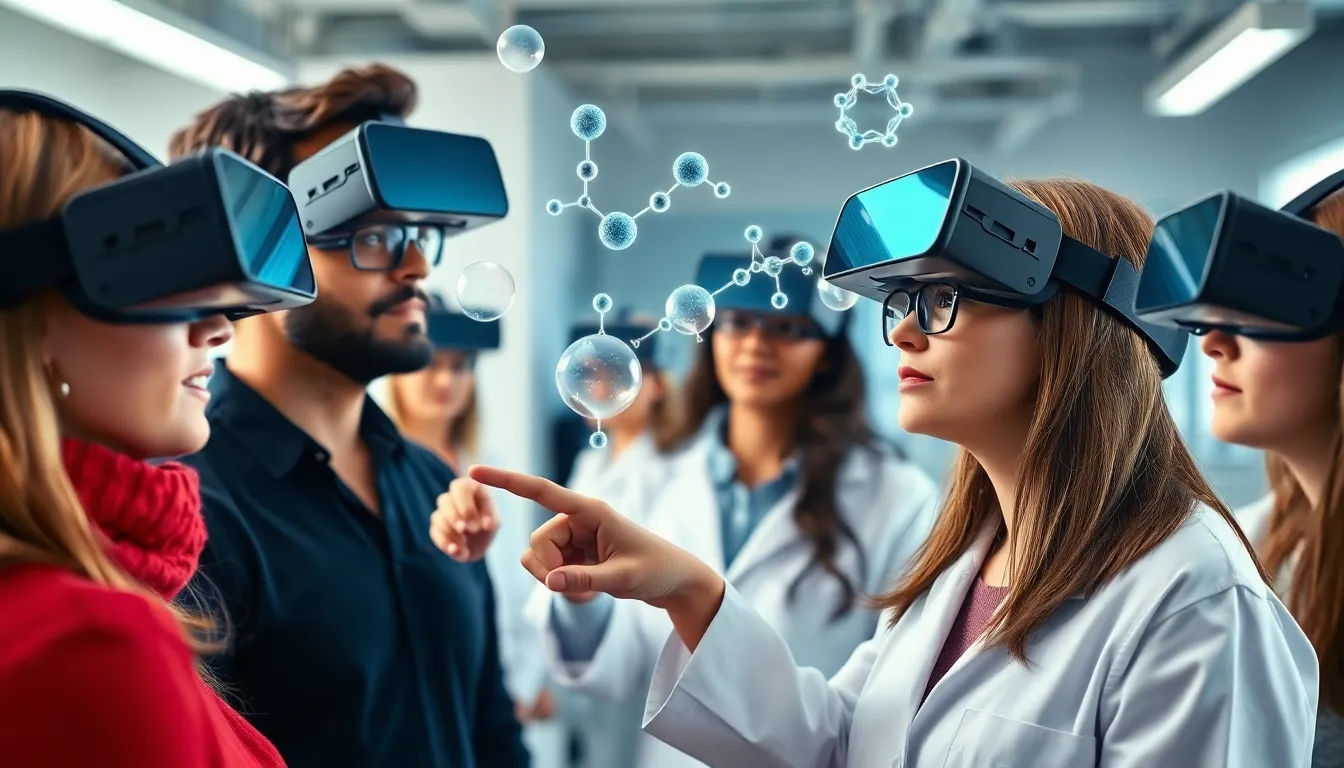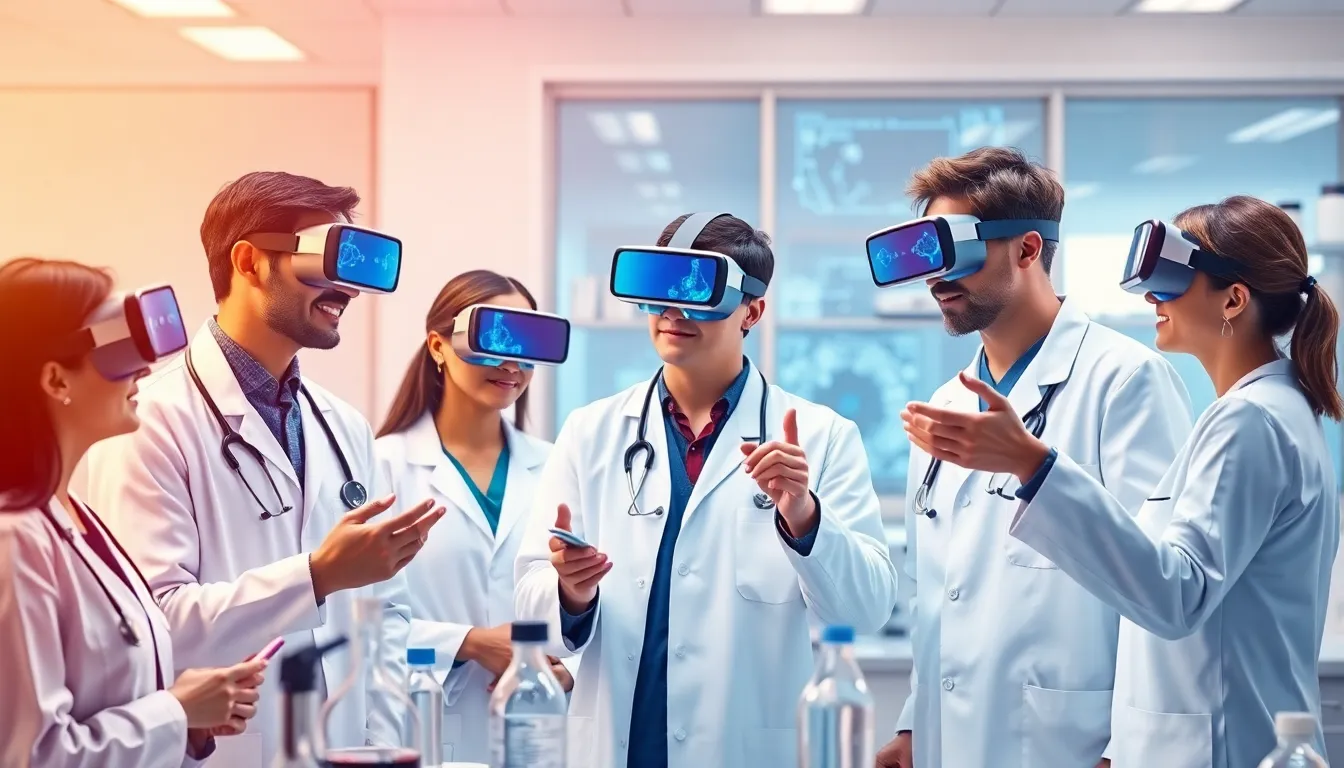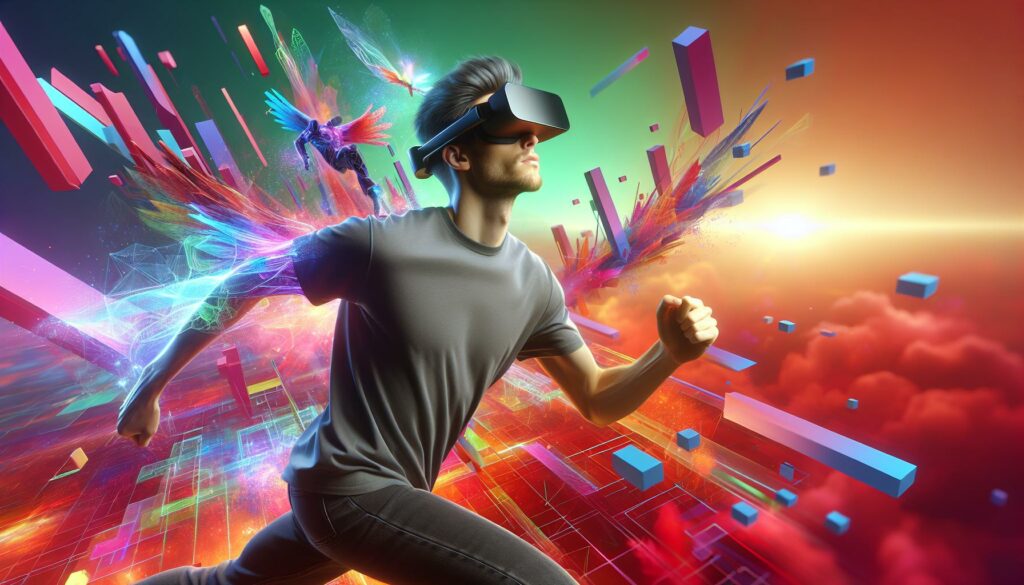In the fast-paced world of pharmaceuticals, innovation is the name of the game. Enter augmented reality (AR) and virtual reality (VR), the dynamic duo shaking things up like a well-mixed cocktail at a corporate retreat. Imagine training medical professionals with lifelike simulations or helping patients visualize complex treatments—all without a single awkward conversation about side effects.
ar vr in pharma
AR and VR technology play crucial roles in the pharmaceutical industry. They enhance training programs for healthcare professionals through immersive simulations. Medical personnel gain hands-on experience in complex procedures, which boosts their confidence.
These innovations also aid patient education by providing engaging visualizations. Patients can explore their treatment plans in 3D, helping them comprehend intricate details. Understanding medications and potential side effects becomes more manageable through interactive scenarios.
Pharma companies integrate AR and VR into research and development processes. Virtual environments facilitate drug discovery, allowing scientists to visualize molecular structures. Collaboration across global teams improves as these technologies provide real-time data sharing.
AR applications support sales representatives by delivering detailed product demonstrations. Visual aids capture the attention of healthcare providers, enhancing communication. This method effectively highlights a drug’s benefits, ensuring clearer understanding during presentations.
Cost reduction occurs as AR and VR minimize the need for physical training spaces. Companies can allocate resources efficiently while maintaining high-quality training experiences. Efficiency increases as simulation training allows healthcare professionals to practice without risks.
Innovative developments continuously emerge in the AR and VR fields. Ongoing research focuses on improving user interfaces and experience. These advancements expand potential applications in pharmaceuticals, paving the way for future solutions.
Overall, AR and VR technologies significantly impact various aspects of the pharmaceutical sector. Their use enhances training, communication, and research, ultimately benefiting both healthcare professionals and patients.
Applications of AR VR in Pharma


AR and VR technologies significantly enhance various aspects of the pharmaceutical industry. Their applications span from drug discovery to patient education, providing innovative solutions that streamline processes and improve outcomes.
Enhancing Drug Discovery
AR and VR improve collaboration among research teams. These technologies allow for the visualization of complex biochemical interactions, making data analysis more intuitive. Researchers can simulate drug behaviors, which accelerates the screening of potential candidates. Additionally, immersive environments enable scientists to design and optimize drugs more efficiently. The integration of AR tools into laboratory settings promotes real-time sharing of findings, enhancing collective insights and driving innovation in drug discovery.
Improving Clinical Trials
The efficiency of clinical trials increases with AR and VR applications. Virtual environments assist in training clinical staff on trial protocols without the need for extensive resources. Patients can experience trial processes in simulated settings, reducing anxiety and increasing participation rates. These technologies also facilitate remote monitoring, allowing real-time data collection and analysis from participants. By streamlining communication between teams and participants, AR and VR contribute to more effective trial management and faster results.
Transforming Patient Education
Patient education receives a boost from AR and VR as well. These technologies create engaging content that simplifies complex medical information. Visual aids help patients understand treatment plans, medication instructions, and potential side effects more effectively. Interactive simulations allow for self-paced learning, catering to individual needs and preferences. Furthermore, AR applications can assist healthcare providers in delivering clear, concise explanations, ensuring that patients feel informed and empowered in their healthcare journey.
Benefits of Implementing AR VR in Pharma
AR and VR technologies deliver multiple advantages in the pharmaceutical industry, enhancing both training and patient engagement.
Increased Engagement
AR and VR foster increased engagement among both healthcare professionals and patients. These immersive technologies enable dynamic experiences that captivate users, encouraging better interaction with educational materials. Patients can visualize treatments, which demystifies complex medical concepts. Medical professionals experience realistic simulations that enhance knowledge retention. Real-time feedback during simulations improves the learning journey. Studies indicate that 70% of learners retain information better with AR and VR environments compared to traditional methods. Engaging content in AR and VR transforms mundane information into compelling narratives, making it easier to grasp key concepts.
Enhanced Training Opportunities
Enhanced training opportunities emerge through AR and VR applications in pharmaceuticals. These technologies provide realistic scenarios, allowing medical professionals to practice skills in a safe environment. Training programs become more effective with simulations that cover complex procedures and drug interactions. Participants can repeat scenarios as much as needed to build confidence. Research shows that simulation-based training leads to a 30% increase in skill acquisition rates. Remote training becomes feasible, enabling collaboration among global teams. Immediate feedback during training sessions reinforces learning outcomes, elevating the overall quality of instruction. Through these advancements, AR and VR significantly improve training frameworks in the pharmaceutical sector.
Challenges and Limitations
The integration of AR and VR in the pharmaceutical industry faces challenges that must be addressed. These technologies, while promising, encounter several obstacles that hinder their full adoption and effectiveness.
Technological Barriers
Technological barriers impede the widespread implementation of AR and VR. High costs associated with hardware and software prevent many companies from adopting these innovations. User experience issues, such as motion sickness or limited interactivity, frustrate users and can lead to diminished engagement. Limited interoperability with existing systems also presents challenges, impacting data sharing and integration into workflows. Finally, developing applications tailored to specific needs in pharma demands significant time and expertise, complicating the transition for many organizations.
Regulatory Considerations
Regulatory considerations play a crucial role in the adoption of AR and VR in pharma. Authorities require rigorous testing and validation of these technologies to ensure safety and effectiveness. Navigating these regulations can be complex, leading to delays in implementation. Furthermore, data privacy concerns arise, especially when handling sensitive patient information. Companies must adhere to strict guidelines, such as HIPAA, which adds additional layers of compliance. Engaging with regulatory bodies early in the development process is essential to streamline approval pathways and facilitate smoother integration into healthcare practices.
Future Trends in AR VR for Pharma
Emerging trends in augmented reality (AR) and virtual reality (VR) are set to reshape the pharmaceutical landscape. Advancements in user interfaces streamline experiences, making them more accessible for users. Enhanced data visualization techniques allow researchers to enjoy deeper insights into drug interactions, which accelerates the drug discovery process.
Developments in mobile AR applications contribute significantly to patient engagement. Patients increasingly benefit from interactive AR tools that simplify treatment explanations, fostering a better understanding of complex medical concepts. Immersive VR simulations continue to train healthcare professionals effectively, leading to increased skill acquisition rates, which rise by up to 30%.
Innovative collaborations emerge as pharmaceutical companies partner with tech firms to push the boundaries of AR and VR applications. Remote monitoring solutions integrate seamlessly with AR and VR, allowing for real-time data collection, which enhances clinical trial efficiency. Tailored AR experiences provide sales representatives with enhanced product demonstrations, yielding better physician engagement and comprehension of a drug’s benefits.
Cost-effective training solutions stand out as AR and VR technologies reduce the need for physical spaces. This transformation helps companies reallocate resources to other crucial areas. Research indicates that healthcare professionals retain information more effectively in AR and VR environments, with retention rates reaching 70%.
Adapting AR and VR technologies to comply with evolving regulatory standards represents a key focus area. Engaging with regulatory bodies early grants developers a clearer path to streamlined approvals. Continuous innovation in this sector leads to more robust applications for both research and patient education, allowing the pharmaceutical industry to meet the growing demands of an ever-evolving healthcare landscape.
Conclusion
The integration of AR and VR in the pharmaceutical industry marks a significant leap forward in enhancing training and patient education. These technologies not only streamline drug discovery but also foster collaboration among teams across the globe. By improving the way medical professionals learn and interact with patients, AR and VR create a more informed healthcare environment.
As the industry continues to evolve, addressing the challenges of adoption will be crucial. Companies must remain proactive in engaging with regulatory bodies to ensure compliance and facilitate smoother integration. The future of AR and VR in pharma looks promising, with ongoing innovations set to transform how healthcare professionals and patients experience the medical landscape.


![[author] arkit and unity: build a drivable car in augmented reality course](https://wzhi58.com/wp-content/uploads/2024/11/1b145239-102d-43d9-8674-80113a75e375_hGjkhjyx0SxSyWk99mwY3-1024x585.jpeg)
